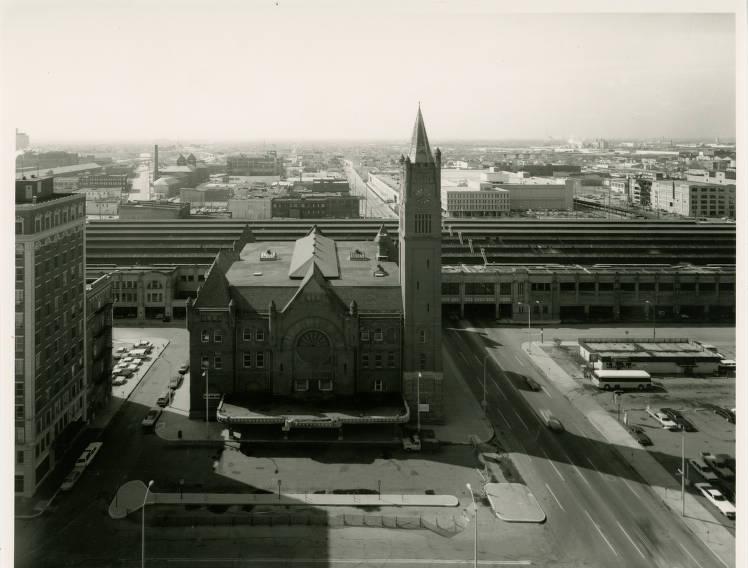The country’s first “union station”—that is, a centralized station for the common use of passengers of independent rail lines—was constructed south of the present station in 1852-1853. Planned by Captain Thomas A. Morris and designed by architect , the brick structure with clerestory (an overstory with windows) served five tracks. At the time, five railroads entered the city. Despite enlargement in 1866, this depot was outgrown within 30 years and was demolished in 1886.

The current Union Station, located at 39 Jackson Place, designed by architect and engineer Thomas Rodd of Pittsburgh, was built as a replacement in 1887-1888. It is one of the finest examples of the Romanesque Revival style in the Midwest and one of the city’s most historically and architecturally significant buildings. The three-story-high, barrel-vaulted, skylit waiting room has been likened to a cathedral and is a beloved public space in Indiana. Major alterations and additions to the station, designed by the local firm of in 1912-1913, resulted in such features as the waiting room’s stained-glass wheel windows, a canopy over the Jackson Place entrance, and the immigrant waiting room.
At the beginning of the 20th century, 200 passenger trains a day passed through the 1880s train shed, which was built of cast iron and wood at grade level. Passengers were forced to walk across tracks to board their trains, and traffic jams occurred when trains blocked vehicles in the streets surrounding the station.
An ambitious program of was begun by 1915. While the 14 elevated tracks and train platforms were completed in 1918, the intervention of World War I delayed completion of the train shed and pedestrian concourse until late 1922. Price and McLanahan of Philadelphia served as architects. Recognized for its major achievements in traffic engineering, the seven-acre train shed complex is among less than a dozen that survive in the United States today.
Union Station went through a slow deterioration during the 20th century. Traffic had almost ceased by 1970 when the Penn Central fell into bankruptcy. Several attempts were made to stabilize the building in the late 1970s following its listing (1974) on the National Register of Historic Places, but it took the comprehensive approach of developer Robert Borns to save the station as a proposed festival marketplace.

Preserving the most significant architectural elements, the $30-million restoration (completed in 1986) focused on retaining the experience of a station in its conversion to over 100 restaurants and shops. As an example of the extensive work necessary in the two-year project, nearly 90 percent of the ornate plaster in the head house, an 1880s building, had to be replaced because of water damage.
The development of the trackside market retained the open structural supports of the train shed, incorporating skylights above and references to the rails in the new floor. was architect of the station’s renovation and the conversion of the west portion of the shed into a hotel; was architect of the train shed’s transformation.

The renovated facility’s early success dimmed in the late 1980s because of low revenues, high turnover among its shops, and inadequate security. New management addressed many of these problems, with mixed success. In 1993, over 4.2 million people were visiting the station’s 34 retail stores, 18 fast food outlets, and 7 restaurants and bars.
By 1997, however, the festival marketplace strategy had been designated a failure, and Indianapolis’ government took ownership of the facility. During this time, Union Station was used as a rental facility for a variety of groups, including a go-kart track and a charter school. Union Station is largely utilized as leased office space. The Crowne Plaza Hotel operates the train shed structure and leases out the main concourse for special events.
No portion of Union Station serves its original purpose. A modern station, located just south of Union Station at 335 South Illinois Street, serves Amtrak and inter-city bus companies.

Help improve this entry
Contribute information, offer corrections, suggest images.
You can also recommend new entries related to this topic.